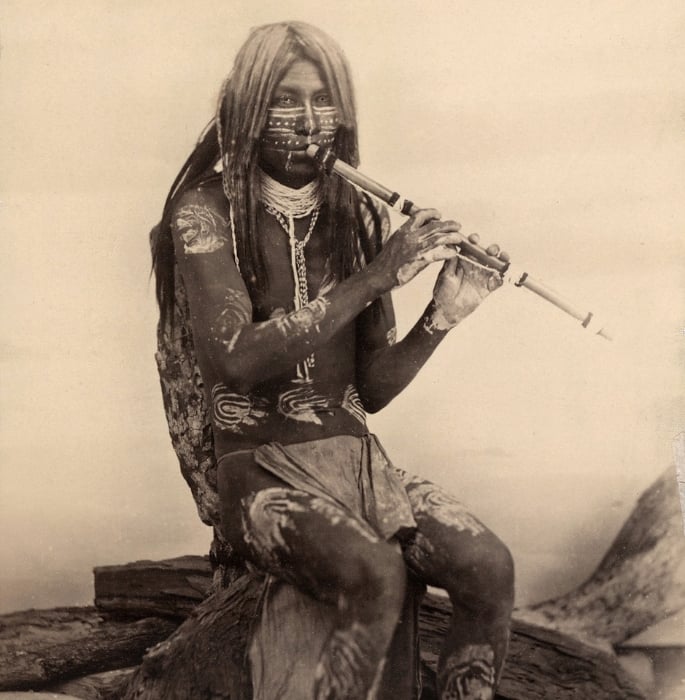The flute is a beautiful woodwind musical instrument dating from 900 B.C.
It has evolved through the years in terms of its shape and use. The earliest flutes were known as “chi-e” which originated in China.
Early flutes were played in either a vertical or horizontal position. The horizontal position is called the transverse position.
The first transverse flute arrived in Europe with traders from the Byzantine Empire during the Middle Ages and travelled to Germany. At that time, it was referred to as the German flute.
To paint a picture, during the 1100s and 1200s, the flute was used in medieval court music. In the Middle Ages, medieval musicians and composers invested in courtly love.
They were made from a single piece of wood, just under two feet long. Themes in their music included poetry about a cherished love for their beloved partners.
Instruments during the Middle Ages followed the vocal model, such as soprano, alto, tenor and bass from the top octaves to the lowest respectively. These are the main vocal ranges for the voice.
To elaborate, music was a key aspect of religious life, and singing in particular was thought to relieve the grief of those at funerals. At the time, medical practitioners believed that music was able to heal wounds and even paralysis.
In the 1300s, Swiss mercenaries popularised the flute which was used for military signalling and marching. In the Renaissance, it became attractive for amateur flute players to play together.
This was known as consort music. By 1600, brass instruments were combined with the flute as mixed consort music.
Italian and Netherlands flute makers began to experiment with the size of the flute, added another note (E flat) and divided the flute into pieces for travel purposes. France’s Louis XIV was a flute enthusiast as at the time the flute was widely known for its sweet and romantic tone.
During the late 1600s and 1700s, the solo flute repertoires emerged. Music was created that featured an extended range, i.e. more lower notes introduced from lower octaves.
The result of this was that the player was able to add more character to their playing. Composers like Vivaldi, Bach, Handel, Telemann and Blavet wrote masterpieces for the solo flute.
Professional players such as J.J. Quantz began to make a statement as he travelled vastly performing in many locales playing the baroque flute. Around 1750, the baroque flute was taken and a system of flute keys was added.
Hence, the lower register was strengthened as there was more solid tuning. By the end of the century, the keyed flute was adopted worldwide.
Every country has their unique style. J.G. Tromlitz, a well-known and proficient German flautist at the time, performed on a keyed flute of his design.
The flute then began to flourish in the first half of the 19th century. There were variations found in Austria, England, America, France and Germany, as well as others.
Theobald Boehm of Bavaria was becoming popular as he was able to find faster fingering in a more natural hand position. In Vienna, the flute had a range down to G on the violin and became ever more popular.
Again, the keyed flute evolved in the 1950s and became known as the Meyer flute. It quickly became adopted in America and Europe. 20 years ahead there came the Boehm-style flute which is used by professional musicians and amateurs alike in the modern day.
A flute essentially is like an open tube and is blown like a bottle. Over time, the flute has evolved to have a complex set of keys and holes. There are several variations of flutes, including traverse, end-blown, and fipple flutes.
Flutes may also be open-ended or closed-ended. Traverse flutes include Western concert flutes: piccolo, fife, dizi, and bansuri.
The earliest transverse flute is a Chi flute. It was discovered in the Tomb of Marquis Yi of Zeng in Hubei province, China. It dates from 433 B.C.E., of the later Zhou Dynasty.
Comprised of bamboo and closed ends, it has five stops that are at the flute’s side instead of the top. Chi flutes are mentioned in the Shi Jing which was the first anthology of Chinese poetry compiled by Confucius (551–479 BC).
End-blown flutes are produced by their sound blowing across an opening at the top of the flute. These include the xiao, ney, kaval, quena, shakuhachi and tonette.
Fipple flutes are distinguished by the player being able to blow above or below the hole. Included in this category are: the recorder, whistle, tin whistle, fujara, and ocarina.
Fipple flutes are easier to play but there is less control for the musician. The ocarina, pan pipes, police whistle, and bosun’s whistle are closed at the bottom end.
However, flutes can be open on one or both ends.
Open-ended include the concert flute and the recorder. This instrument has greater tonal flexibility as well as a certain bright-sounding quality.
It has an embouchure hole where the player blows through. The standard concert flute is pitched in C and has a range of three octaves starting from middle C.
This is by far the most commonly played. The modern professional concert flute is generally made of silver, gold, or combinations of the two.
There is also a variation of wooden flutes which are used to produce warmer tones. The modern concert flute comes with various options.
The B-flat thumb key (invented and pioneered by Briccialdi) is practically standard. The concert flute family has a variety of instruments beginning with the piccolo.
The piccolo is a small traverse flute usually pitched one octave above the concert flute. During the Baroque period, French flute makers added the first key and made developments to the instrument.
The Frenchman Thomas Lot became world famous for his four-piece one-keyed flutes. Controversially manufacturers were adding more keys to improve the finger technique.
French flautists objected to this is, hence it took time to standardise the instrument. This came about long after the violin.
However, in the eighteenth century, more keys were added and the four-keyed flute. In the Baroque period, most flautists composed their music and continued until the Romantic period.
At first, during the Romantic era, the eight-keyed flute was the standard instrument and then Theobald Boehm came with his invention in 1832. In the twentieth century, there is an enormous contribution of French composers to the repertoire for the flute.
France produced many talented flautists who helped spread the flute tradition far beyond the borders of France. Flute students from all over the world came to Paris to learn from the profound teachers.
The flute became popular in France with the troubadours. French flutes are characterised by their open hole.
It’s understood that this allows a louder and clearer sound in the lower range. They are prevalent in avant-garde music and enable the player to play harmonic overtones.
Moreover, the player can manipulate a breathy sound as well as a pure one. Open-hole keys are typical of French technique, renowned and famously played by the Paris Conservatoire.
Tradition has it that the Native American flute was used to court and charm women. A young man would make a flute, set himself off from the group he was with and play a song that he and his beloved knew.
As he expresses himself through the flute, the woman understands his emotions and intentions. Once they became a couple the man would throw away the flute and never play another again.
Also, in native culture, the songs were not played by others unless they were gifted. Due to the maker, the size is based on their hands, fingers and thumbs.
In the modern day, the music of the Native American flute is heard in Western music such as rock bands, jazz quartets and symphony concertos. It is also blended into Western scales.
In addition, there are also flutes from Meso American: Mexico and Central America. These flutes are similar to Native American flutes, in that they are both fipple flutes but have their differences.
For instance, Meso-American flutes are traditionally made of clay or river cane and rarely wood. Traditionally the flute embodies the four sacred elements of life: Earth, Water, Fire, and Wind.
These flutes include dizi and bangdi which are transverse flutes. There is Xiao which is an end-blown vertical flute. There is the Gudi which is vertical and made from the bones of large birds.
As well as Paixiao which is pan pipes, Koudi which is a very tiny bamboo flute, and Xun which is a clay ocarina. Pottery figurines of players of end-blown flutes (today called xiao, also spelt hsiao) survive from the Han Dynasty (206 BC–220 AD).
Transverse flutes (today called di or dizi) became common later, though some sources state that they, along with the xiao, arrived in China from the western regions during the Han Dynasty. Dizi traditionally, is made of a piece of bamboo with six finger holes, an embouchure hole, and an extra hole.
It makes a distinct nasal and buzzing sound. The dizi is also one of the few wind instruments in the Confucian ceremonial orchestra.
In Taiwan, the dizi is mainly used for Confucian sacrificial ceremonies (jikong dianli). During the eighteenth century, the dizi was used in many musical traditions in Taiwan such as beiguan and Hakka bayin.
This has cultural links such as the Hindu god Krishna was said to be the master of this instrument. The Indian bamboo flutes are made of bamboo and are keyless.
There are two variations. The first is the Bansuri, from the music of North India which has six finger holes and one blowing hole and is used in Hindustani music.
The Bansuri was used traditionally for cattle herders. It marked the sacred love of Krishna and Sri Radha.
It is linked to spiritual awakening and acts as a divine call for followers. In stories, the flute was played to surrounding animals.
The word Bansuri comes from the word “banse” in Hindi meaning bamboo. In ancient times, it was a folk instrument played to accompany dancers at weddings and religious events.
Pannalal Ghosh, in the 1940s in India, transformed the simple folk instrument to become popular in classical and popular Indian music. Today, it is accompanied by the tabla or the tanpura.
The second is Venu or Pullanguzhal, which has eight finger holes, used in Carnatic music, the music of south India. It has appeared in Natya Shastra, the classic Hindu text on music and performance arts.
The flute has evolved through time. Keys and holes have been introduced over the years. The music that is played represents a different culture.
Whether it’s court women, soothe animals, or symbolically represent ideals the flute is widely prevalent in our history.












